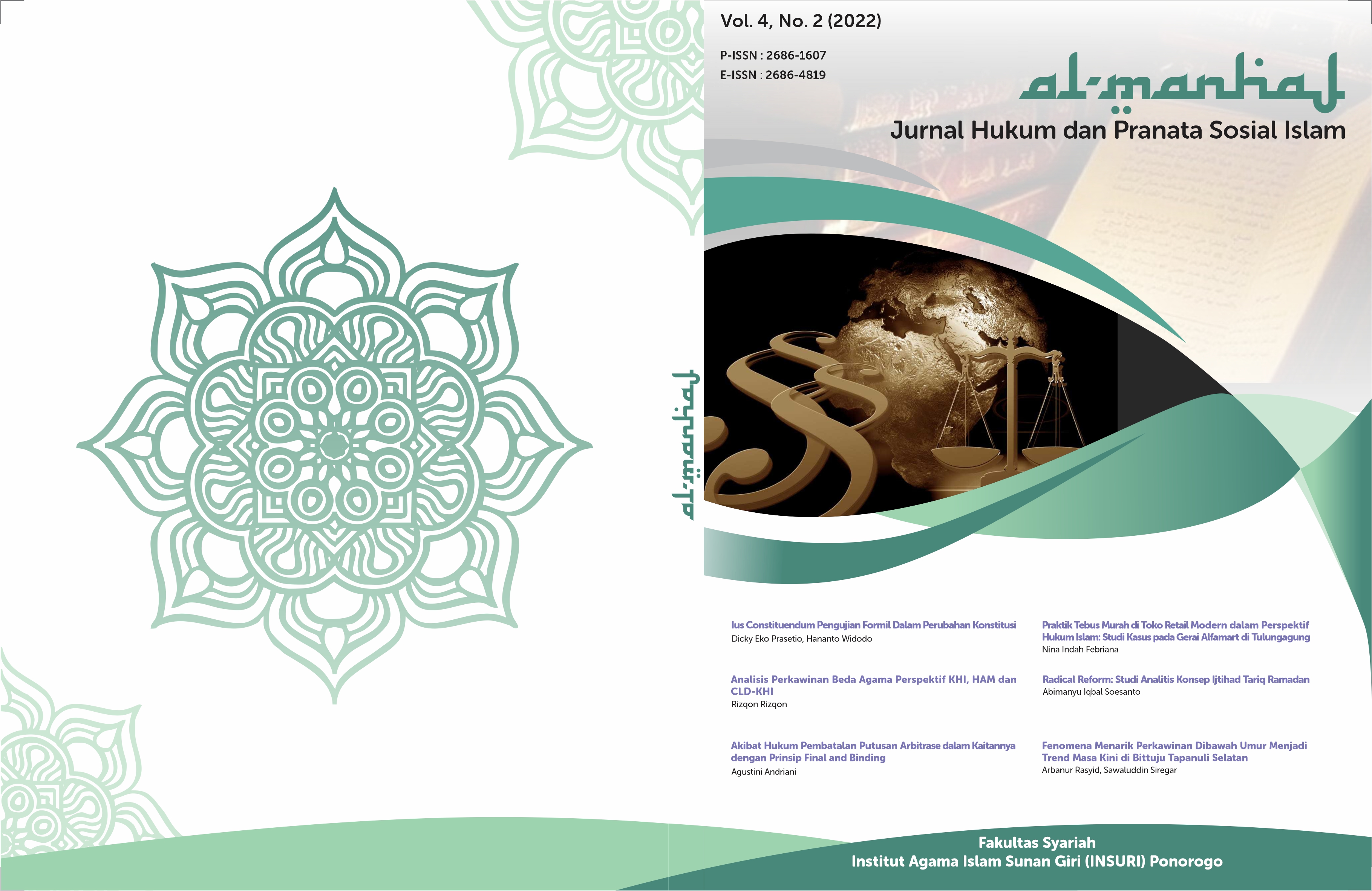Perjodohan Adat: Dampak dan Implikasi Hukum UU No. 16 Tahun 2019 Tentang Perkawinan di Indonesia
DOI:
https://doi.org/10.37680/almanhaj.v4i1.1577Keywords:
Perjodohan, Adat, Dampak, Implikasi, HukumAbstract
Traditional matchmaking in East Sumba Regency has long been considered a tradition that needs to be continued even though it has many weaknesses that need to be avoided. one of them is if matchmaking is closely related to coercion to children who will be matched. The purpose of this study was to see the true meaning of customary matchmaking and the legal impact on perpetrators of forced matchmaking based on Law 16 of 2016 concerning marriage. The research method used in this research is normative empirical based on evidence, both by reviewing legal documents such as laws and by observation and in-depth interviews so that this study can draw clear conclusions regarding the function of matchmaking in the reality of the indigenous people of East Sumba. The results of the study found that on average, customary marriages that had occurred were carried out at the age of 12-16 years. This study 29% of matchmaking that still occurs in East Sumba is carried out by minors, so if this is still the case then the deprivation of independence is certainly an argument that needs to be punished.
References
Anggraeni, Sylvia Asih, ed., 2005, East Sumba A Hidden Treasure in The Archipelago, Pemda Kab. Sumba Timur, Waingapu.45-49
Dianistrini (2019). Polemik Perjodohan Dini dan Pernikahan Dini. Diakses pada 20,06,2022, dari Fopini.blog.id: https://fopini.id/polemik-tradisi-perjodohan-dan-pernikahan-dini-di-madura/
Hamdani, P. (2013). Status Sosial dalam Penetapan Uang Belanja Pada Perkawinan Masyarakat Bugis (Studi Kasus Masyarakat Desa Cakkeware Kecamatan Cenrana Kabupaten Bone) (Doctoral dissertation, Universitas Negeri Makassar).
Harun Nasution, 1987,Hak Asasi Manusia dalam Islam,Jakarta: Pustaka Firdaus,80-99
Indah,RH, dkk, 2017,Pengaruh Kultur Budaya Terhadap Tingkat Kemiskinan di kabupaten Sumba Timur, Jurnal Transformatif Vol 7, No. 1,27
Internet atau Website
Ishaq, 2017,Metode Penelitian Hukum, Bandung : Alfabeta,26-30
Marchlewska, M., Cichocka, A., Łozowski, F., Górska, P., & Winiewski, M. (2019). In search of an imaginary enemy: Catholic collective narcissism and the endorsement of gender conspiracy beliefs. The Journal of Social Psychology, 159(6), 766--779.
Muhammad Basrowi. 2004. Teori Sosial Dalam Tiga Paradigma. Surabaya. UK Press.
Munawar, A. (2015). Sahnya Perkawinan Menurut Hukum Positif Yang Berlaku Di Indonesia. Al-Adl: Jurnal Hukum, 7(13).
Muthmainnah Lailiy, dkk, 2010, Ruang Privat Individu Dalam Sistem Kawin Mawin Masyarakat Sumba Timur Jurnal Filsafat Vol.20, Nomor 3
Narwoko, Dwi J. dan Bagong Suyanto. 2006. Sosiologi Teks Pengantar dan Terapan.Jakarta: Kencana.
Ritzer George dan Douglas J Goodman. 2009. TeoriSosiologi. Yogyakarta: KreasiWacana.
Sa, M. (2016). Perkawinan Beda Agama: Perspektif Islam Progresif. Kontemplasi: Jurnal Ilmu-Ilmu Ushuluddin, 4(2), 317-336.
Undang-Undang Nomor 16 Tahun 2019 tentang Perubahan Atas Undang-Undang Nomor 1 Tahun 1974 tentang Perkawinan
VOA Indonesia (2020). Kawin Paksa:Janji terucap karena adat. Diakses pada 20,06,2022 dari VOA.Indonesia: https://www.voaindonesia.com/a/kawin-paksa-janji-terucap-karena-tuntutan-adat/5585449.html
Downloads
Published
How to Cite
Issue
Section
License
Copyright:
- Author retains the copyright and grants the journal the right of first publication of the work simultaneously licensed under a Creative Commons Attribution 4.0 International License that allows others to share the work with an acknowledgment of the work's authorship and initial publication in this journal.
- Author is able to enter into separate, additional contractual arrangements for the non-exclusive distribution of the journal's published version of the work (e.g., post it to an institutional repository or publish it in a book) with the acknowledgment of its initial publication in this journal.
- Author is permitted and encouraged to post his/her work online (e.g., in institutional repositories or on their website) prior to and during the submission process, as it can lead to productive exchanges, as well as earlier and greater citation of the published work (See The Effect of Open Access).
License:
-
Attribution — You must give appropriate credit, provide a link to the license, and indicate if changes were made. You may do so in any reasonable manner, but not in any way that suggests the licensor endorses you or your use.
-
No additional restrictions — You may not apply legal terms or technological measures that legally restrict others from doing anything the license permits.
You are free to:
- Share — copy and redistribute the material in any medium or format
- Adapt — remix, transform, and build upon the material for any purpose, even commercially.

This work is licensed under a Creative Commons Attribution 4.0 International License.














